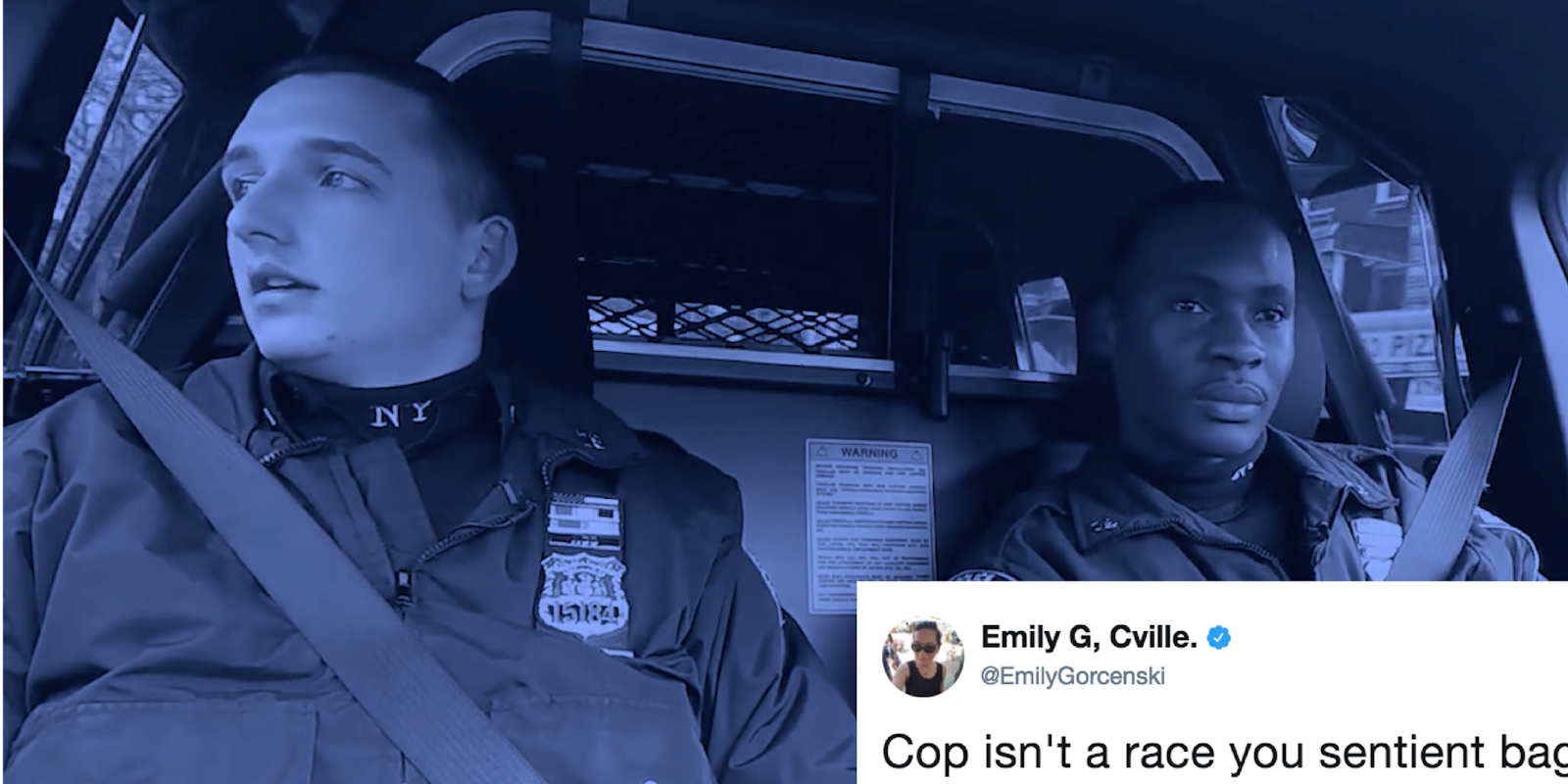The Sergeants Benevolent Association, a police union that reportedly represents 13,000 current and former New York Police Department sergeants, is asserting in a new video that “blue racism” affects police officers and is an “even more racist lens” than racism itself—and the internet is not having it.
In the video, a narrator asserts that despite police officers being human, they’re discriminated against through “blue racism,” waxing that they’re attacked, generalized, and unable to discuss their profession in their private life, but are still required to protect communities that generalize them.
“The average person doesn’t see those things that make me human. They don’t even label me based on being African-American, Latino, Asian, Caucasian and so on. They tend to see an even broader stereotype through an even more racist lens,” the narrator says. “When they look at me, they see blue.”
The video ends by condemning “the Nazi, white supremacist actions and rhetoric” witnessed during white supremacist rallies in Charlottesville, Virginia, earlier this month, and sharing thoughts and prayers for the victims of violence and the two officers killed in a related helicopter crash.
Members of law enforcement have become the targets of racism: Blue Racism. Watch this video to learn more: https://t.co/sI7WGUrZfn
— SBA (@SBANYPD_Archive) August 21, 2017
Shared on Sunday night, the video appears to be part of the union’s video series titled “There is NO WE in Barry.” Upon closer inspection of the union’s Vimeo and YouTube accounts, it seems the series denounces the comments of NYPD Commissioner James O’Neill upon the fatal police shooting of Deborah Danner in October.
The union rejects O’Neill’s assertion that “we failed” in training Sgt. Hugh Barry how to work with New Yorkers with mental illness, going so far as to deconstruct and mock the comments in several videos. In May, Barry was charged with second-degree murder in Danner’s death, as well as first- and second-degree manslaughter, and criminally negligent homicide.
The video does draw upon examples of targeted violence against police—such as the intentional shooting of police during a peaceful Black Lives Matter rally in Dallas last year, and more recently the death of two officers who were ambushed while responding to a call in Kissimmee, Florida. Working in law enforcement can be dangerous, without a doubt.
However, while calls to end racial profiling and police brutality have placed a brighter spotlight on the actions of police, particularly white officers, many Twitter users swiftly rejected the assertion that police suffer from racism due to their profession.
https://twitter.com/Kno/status/899929553304301568
Cop isn’t a race you sentient bags of fungal cream https://t.co/zGwH5JSYQH
— Emily Gorcenski (@EmilyGorcenski) August 21, 2017
Thanks for reminding us that police r regular ppl. We agree. That’s why u should face the same consequences for killing innocent ppl. #jail https://t.co/3BeZ0inDYh
— Tamika D. Mallory (@TamikaDMallory) August 22, 2017
Unlike police affected by so-called “blue racism,” Black people and non-Black people of color are unable to go home at the end of the day and “take off” their race to avoid prejudiced interactions, much like a cop would their uniform. They did not choose their race, nor do they automatically derive systemic power from being a person of color, much like a cop has systemic authority as a law enforcer.
That’s not to say that choosing to be in law enforcement should ever be a death sentence, but it’s an explanation for why the prejudice police experience cannot be compared to de facto racism.
So you’re saying the uniforms form in the womb and can’t be removed?
— Forest Plinth (@Matt_Hecht) August 21, 2017
https://twitter.com/SaddestRobots/status/899454560783269889
https://twitter.com/2TwelveHundreds/status/899446939133128705
https://twitter.com/iskandrah/status/899439948339847168
Blue racism?????? GET ALL THE WAY THE FUK OUTTA HERE ….
— little farma (@stylesp) August 22, 2017
https://twitter.com/CartoonzNCereal/status/900028354128207872
Other critics have pointed to the “real” victims of blue racism—animated characters who have blue skin, obviously.
https://twitter.com/fivefifths/status/899614146706235392
the gargamel community has yet to respond with a statement https://t.co/AsSn43YcrM
— Goth Ms. Frizzle (@spookperson) August 21, 2017
There’s no such thing as Blue Racism, except for Smurfs, and everybody knows Smurfs are all shiftless lazy welfare cheats and gang members.
— TDP (@TDPattillo) August 22, 2017
https://twitter.com/BlondeinKevlar/status/900041745806770176
In an interview with the New York Times, union president Edward D. Mullins admitted that the “negative component” of the video has been “using the word ‘racism.’”
“From the law-enforcement perspective, everyone understands the message—the message being, we’ve been pretty much under attack,” Mullins said. “I guess we could have not used the word ‘racism,’ but something like ‘bias.’ But regardless of race, the country has been upside-down with protests and battles.”
However, despite the union’s misunderstanding of what racism really entails, he wants to bring people from across the divide together for an “amicable” conversation.
“We’re not the bad guys,” Mullins said.


